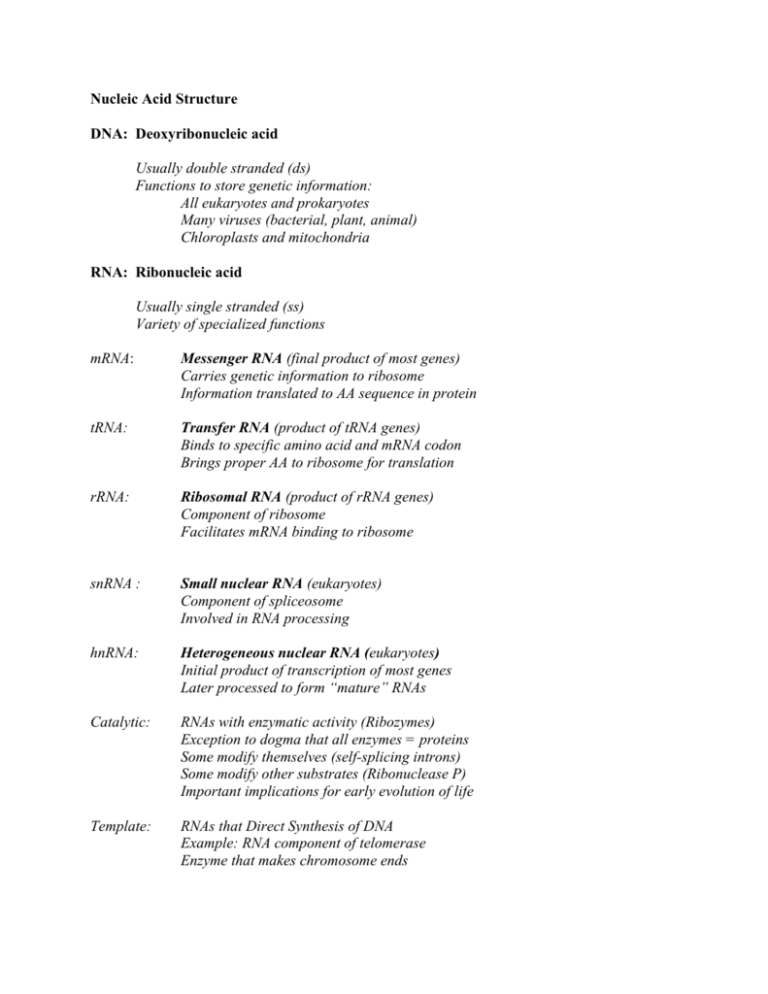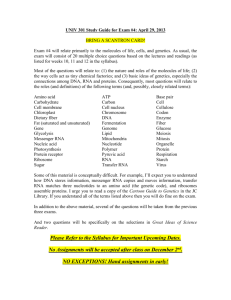Part 2
advertisement

Nucleic Acid Structure DNA: Deoxyribonucleic acid Usually double stranded (ds) Functions to store genetic information: All eukaryotes and prokaryotes Many viruses (bacterial, plant, animal) Chloroplasts and mitochondria RNA: Ribonucleic acid Usually single stranded (ss) Variety of specialized functions mRNA: Messenger RNA (final product of most genes) Carries genetic information to ribosome Information translated to AA sequence in protein tRNA: Transfer RNA (product of tRNA genes) Binds to specific amino acid and mRNA codon Brings proper AA to ribosome for translation rRNA: Ribosomal RNA (product of rRNA genes) Component of ribosome Facilitates mRNA binding to ribosome snRNA : Small nuclear RNA (eukaryotes) Component of spliceosome Involved in RNA processing hnRNA: Heterogeneous nuclear RNA (eukaryotes) Initial product of transcription of most genes Later processed to form “mature” RNAs Catalytic: RNAs with enzymatic activity (Ribozymes) Exception to dogma that all enzymes = proteins Some modify themselves (self-splicing introns) Some modify other substrates (Ribonuclease P) Important implications for early evolution of life Template: RNAs that Direct Synthesis of DNA Example: RNA component of telomerase Enzyme that makes chromosome ends Viroid: Unusual, infectious RNAs in plants Smaller and more reduced than viruses Do not code for proteins Cause disease symptoms in plants Genome: Genetic material of RNA virus (TMV; HIV) Conclude: RNAs have many different functions However: All nucleic acids are related in structure Nucleotide: [P] – [S] – [NB] P= S= N= Pentoses: Phosphate group Pentose sugar Nitrogenous base 5-Carbon Sugars DNA: Deoxyribose RNA: Ribose [-H] on 2’ carbon atom [-OH] on 2’ carbon atom Phosphates attach to 5’ and 3’ carbon atoms Nitrogenous base attaches to 1’ carbon atom Nitrogenous Bases: Purines: Double heterocyclic ring Adenine (A) and Guanine (G) Pyrimidines: Single heterocyclic ring Cytosine (C) Thymine (T) in DNA Uracil (U) in RNA Nucleoside: [S] – [NB] Nucleotide: Nucleoside + Phosphate(s) Nucleoside triphosphate: NTP: ATP, GTP, CTP, UTP dNTP: dATP, dGTP, dCTP, dTTP Structure: [PPP]-[S]-[NB] Nitrogenous base pairing: Between purine on 1 strand and pyrimidine on complementary strand A : T and G : C Hydrogen Bonding: A:T = 2 and G:C = 3 H bonds >N ..... H – N < and > C = O ..... H – N < Location: Between bases on complementary strands ds DNA: Paired Strands are Anti-parallel 5’ 3’ [P] [P] [S] [NB] [NB] [S] [S] [NB] [NB] [S] [S] [NB] [NB] [S] [S] [NB] [NB] [S] [S] [NB] [NB] [S] [S] [NB] [NB] [S] [S] [NB] [NB] [S] [P] [P] [P] [P] [P] [P] [P] [P] [P] [P] [P] [P] [P] [P] [S] [NB] [NB] [S] [P] [P] [S] [NB] [NB] [S] [P] [P] [S] 3’ [NB] [NB] [S] 5’ Physical Properties of ds DNA: Structure determined by X-ray crystallography Right-handed double helix Width ~ 20 Angstroms (2 nm) Length ~ 3.4 Angstroms / bp 10 bp / complete turn of double helix Major and minor grooves – binding sites Hydrophilic (charged) backbone Hydrophobic core of stacked bases Several related structural forms (A,B,Z....) Differ in: Tightness of bp stacking Number of bp per turn Biological significance






